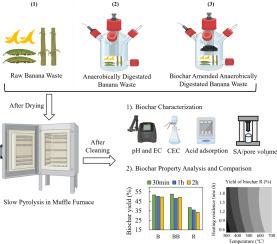从生的和厌氧消化的香蕉废物中提取生物炭的生产和特性
Q1 Environmental Science
引用次数: 0
摘要
木质纤维素废弃物的热解和厌氧消化(AD)作为生态友好型能源生产技术受到越来越多的关注。香蕉废料在热带地区大量产生。本研究研究了不同热解条件下原料和厌氧消化香蕉废弃物的生物炭生产和表征。当热解温度从300℃增加到700℃时,生物炭产率和阳离子交换容量(CEC)分别下降28.0 ~ 52.7%和77.8 ~ 93.6%,而乙酸吸附容量增加67.0 ~ 1143.3%。延长热解停留时间使低温(300℃)下的生物炭产率从38.6% ~ 55.5%降低到33.6 ~ 51.5%,但在所有温度下的酸吸附能力提高了~ 244%。生香蕉废弃物在生产生物炭方面的表现优于厌氧消化废弃物,CEC和酸吸附能力分别提高了~ 359%和501%。从香蕉废料中产生的生物炭的CEC比从木材中提取的生物炭高0.8-28.1倍,这表明这些材料在农业和环境应用方面很有前景。本文章由计算机程序翻译,如有差异,请以英文原文为准。

Production and characterization of biochar derived from raw and anaerobically digested banana waste
Pyrolysis and anaerobic digestion (AD) of lignocellulosic wastes have gained increased attention as eco-friendly energy production technologies. Banana waste is produced in large quantities in tropical regions. This study investigates biochar production and characterization from raw and anaerobically digested banana waste under varying pyrolysis conditions. Increasing pyrolysis temperatures from 300 °C to 700 °C resulted in a decrease in biochar yield and cation exchange capacity (CEC) by 28.0–52.7 % and 77.8–93.6 %, respectively, while acetic acid adsorption capacity increased by 67.0–1143.3 %. Extending the pyrolysis residence time decreased biochar yields at lower temperature (300 °C) from 38.6 to 55.5 % to 33.6–51.5 %, but increased acid adsorption capacities at all temperatures by ~244 %. Raw banana waste outperformed anaerobically digested waste for biochar production, with CEC and acid adsorption capacities enhanced by ~359 % and 501 %, respectively. Biochars produced from banana wastes demonstrated 0.8–28.1 times higher CEC compared to wood-derived biochar, indicating that these materials are promising for agricultural and environmental applications.
求助全文
通过发布文献求助,成功后即可免费获取论文全文。
去求助
来源期刊

Bioresource Technology Reports
Environmental Science-Environmental Engineering
CiteScore
7.20
自引率
0.00%
发文量
390
审稿时长
28 days
 求助内容:
求助内容: 应助结果提醒方式:
应助结果提醒方式:


